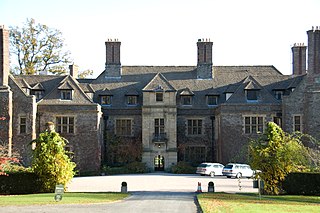
Llangoed Hall is a country house hotel, near the village of Llyswen, in Powys, Mid Wales. It is known for its decoration in Laura Ashley fabrics and styles, and was owned by Sir Bernard Ashley, the widower of the designer. It is a Grade II* listed building, and its gardens and park are listed at Grade II on the Cadw/ICOMOS Register of Parks and Gardens of Special Historic Interest in Wales.

Cefn Mably House is a mansion situated in Cefn Mably, Caerphilly County Borough, Wales. It is a Grade II listed building. The gardens surrounding the house are listed on the Cadw/ICOMOS Register of Parks and Gardens of Special Historic Interest in Wales.
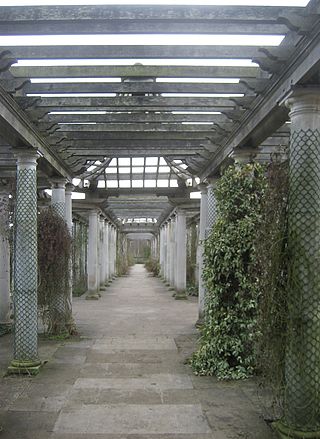
Thomas Hayton Mawson, known as T. H. Mawson, was a British garden designer, landscape architect, and town planner.

Dyffryn Gardens, also spelt Duffryn Gardens, is a collection of botanical gardens located near the villages of Dyffryn and St. Nicholas in the Vale of Glamorgan, Wales. The gardens were selected by the British Tourist Authority as one of the Top 100 gardens in the UK and are in the care of the National Trust. They are designated at Grade I, the highest grade, on the Cadw/ICOMOS Register of Parks and Gardens of Special Historic Interest in Wales.
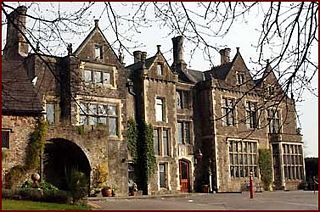
Miskin Manor is a Victorian manor house built in 1864 in a Tudor style, situated in the village of Miskin in Rhondda Cynon Taf, south Wales. The estate was owned by the Williams family including Rhys Rhys-Williams for many years who were descended from the Welsh bard David Williams. Today, the manor is used as a hotel and venue for wedding receptions. It was once filmed for the Doctor Who series 5 finale The Big Bang.
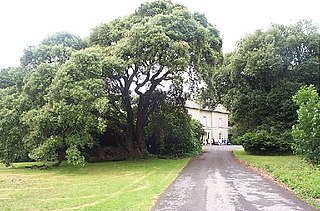
Scolton Manor is a Victorian country house and country park located in Pembrokeshire, West Wales northeast of Haverfordwest and on the borders of the Pembrokeshire Coast National Park. Built as a home, it is now a museum and is a Grade II* listed building. The stable court, some 120 m (130 yd) to the north, is also a Grade II listed building and both are owned by Pembrokeshire County Council. The gardens and parkland are listed on the Cadw/ICOMOS Register of Parks and Gardens of Special Historic Interest in Wales. The house, grounds and a number of exhibits are open to the public.

Wonastow Court, in Wonastow, Monmouthshire, Wales, is a 19th-century country house with earlier origins and later additions. The court is a Grade II listed building, and its gardens are listed, also at Grade II, on the Cadw/ICOMOS Register of Parks and Gardens of Special Historic Interest in Wales.
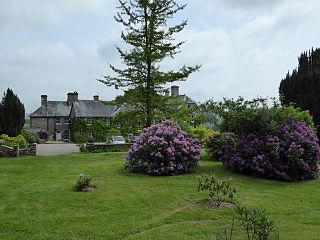
The Argoed, Penallt, Monmouthshire, Wales, is a Victorian country house dating from the 1860s, with earlier origins from the late 16th and early 17th centuries. It is a Grade II* listed building and the garden is listed on the Cadw/ICOMOS Register of Parks and Gardens of Special Historic Interest in Wales. The English meaning of the Welsh word argoed is 'by a wood'.

High Glanau is a country house and Grade II* listed building within the community of Cwmcarvan, Monmouthshire, Wales. It is located about 5 miles (8.0 km) south-west of Monmouth, and 1.5 miles (2.4 km) north of Trellech, adjoining the B4293 road and with views westwards over the Vale of Usk. Commissioned by Henry Avray Tipping and designed by Eric Francis, it is particularly noted for its gardens which are listed at Grade II* on the Cadw/ICOMOS Register of Parks and Gardens of Special Historic Interest in Wales.

Bodorgan Hall is a country house and estate located in the hamlet of Bodorgan, Anglesey, Wales, situated near the Irish Sea in the southwestern part of the island. The hall is the seat of the Meyricks, and is the largest estate on Anglesey. The hall is the home of Sir George Meyrick and his wife, Lady Candida Tapps Gervis Meyrick.

In the United Kingdom, the term listed building refers to a building or other structure officially designated as being of special architectural, historical, or cultural significance; Grade II* structures are those considered to be "particularly important buildings of more than special interest". Listing was begun by a provision in the Town and Country Planning Act 1947. Once listed, strict limitations are imposed on the modifications allowed to a building's structure or fittings. In Wales, the authority for listing under the Planning Act 1990 rests with Cadw.

Monmouthshire is a county and principal area of Wales. It borders Torfaen and Newport to the west; Herefordshire and Gloucestershire to the east; and Powys to the north. The largest town is Abergavenny, with the other major towns being Chepstow, Monmouth, and Usk. The county is 850 km2 in extent, with a population of 95,200 as of 2020. The present county was formed under the Local Government (Wales) Act 1994, which came into effect in 1996, and comprises some sixty percent of the historic county. Between 1974 and 1996, the county was known by the ancient title of Gwent, recalling the medieval Welsh kingdom. In his essay on local government in the fifth and final volume of the Gwent County History, Robert McCloy suggests that the governance of "no county in the United Kingdom in the twentieth century was so transformed as that of Monmouthshire".

Chateau Rhianfa is a Grade II*-listed former house which has been converted into a hotel. Its gardens are listed as Grade II* on the Cadw/ICOMOS Register of Parks and Gardens of Special Historic Interest in Wales.

Ffynone is a mansion and estate near Boncath, Pembrokeshire, Wales, in the parish of Manordeifi. The original Georgian design was by the architect John Nash, and the house was later remodelled by Inigo Thomas. It is a Grade I listed building, and its gardens and park are also listed, at Grade I, on the Cadw/ICOMOS Register of Parks and Gardens of Special Historic Interest in Wales.

Llanerch Hall, Trefnant, Clwyd, Wales, is a country house with medieval origins. It was rebuilt twice at the beginning and at the end of the 17th century, was again rebuilt in the 19th century, and further modified in the 20th. The hall is now divided into flats, each with its own Grade II* listing. The parkland, now a golf course, conceals traces of a late 17th century Italianate terraced garden that rivalled those at Powis Castle. The gardens were entirely destroyed in the 19th century rebuilding. The house remains privately owned.

Trewyn House, Llanvihangel Crucorney, Monmouthshire, Wales, is a country house dating from 1692. Its origins are older but the present building was constructed by the Delahayes at the very end of the 17th century when the house sat in Herefordshire. It has since been extended and reconstructed giving an "obscure and complicated" building history. The house is Grade II* listed. The parkland has traces of 17th-century terracing and a rare Grade II* listed dovecote. It is listed Grade II on the Cadw/ICOMOS Register of Parks and Gardens of Special Historic Interest in Wales.

Lower Dyffryn House, Grosmont, Monmouthshire is a farmhouse dating from the 16th century. Owned by a Sheriff of Monmouthshire in the early 1600s, it was rebuilt by the Cecil family in the mid 17th century as a substantial mansion to the typical Elizabethan e-plan. Its fortunes declined in the 19th century by which point it had been reduced to a farmhouse and much of its external and internal fittings were removed or replaced. The farmhouse is Grade II* listed and a number of the ancillary buildings have their own Grade II listings. The gardens, which are contemporaneous with the house, are included on the Cadw/ICOMOS Register of Parks and Gardens of Special Historic Interest in Wales.

Glen Usk, Llanhennock, Monmouthshire is a country house dating from 1820. It was built for Sir Digby Mackworth, Bt. in the Neoclassical style. The house is Grade II* listed and the adjoining temple, and other associated structures, have their own Grade II listings. The gardens are included on the Cadw/ICOMOS Register of Parks and Gardens of Special Historic Interest in Wales.

Kemeys Manor, Langstone, Newport, Wales, is a manor house dating from the 13th century. The family that built it was established in South Wales in the Middle Ages by Edward, Lord of Kemeys and the manor was held by his descendants until the 18th century. The building was greatly enlarged in the 16th and 17th centuries and comprises a tower, hall and attached ranges. Kemeys is a Grade II* listed building. A barn to the north of the house, and Kemeys Folly to the south, are both listed at Grade II. The park surrounding the house is listed Grade II on the Cadw/ICOMOS Register of Parks and Gardens of Special Historic Interest in Wales. The manor and the folly remain private residences and are not open to the public.

Caerphilly County Borough is a county borough in south-east Wales. It covers an area of 227 km2 (88 sq mi). In 2021 the population was approximately 176,000.




















